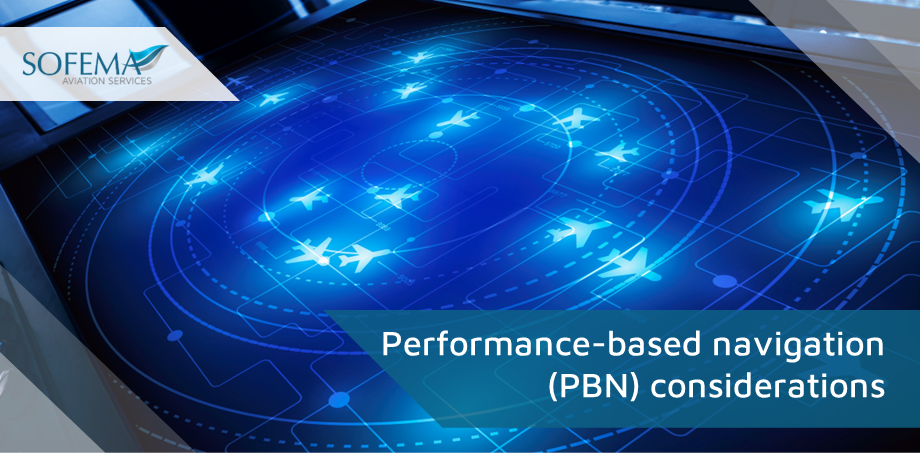Sofema Aviation Services (SAS) considers the role & purpose of Performance-based Navigation (PBN).
Within a PBN framework, RNAV and RNP system performance requirements are defined in terms of:
- Accuracy,
- Integrity,
- Continuity, and
- Functionality.
Performance requirements are identified in navigation specifications at a sufficient level of detail to facilitate global harmonization by providing specific implementation guidance for States and operators.
Under PBN Operators evaluate options in respect of available technology and aviation services, which could allow the requirements to be met.
PBN primarily identifies navigation requirements irrespective of the means by which these are met.
An operator has the opportunity to select the most cost-effective option (Technology can evolve over time without requiring the operation itself to be reviewed.)
Note: It is anticipated that other means for meeting the requirements of the navigation specifications will be evaluated and may be included in the applicable navigation specifications, as appropriate.
PBN Advantages
- Reduces the need to maintain sensor-specific routes and procedures, and their associated costs;
- Avoids the need for developing sensor-specific operations with each new evolution of navigation systems, which would be cost-prohibitive;
- Allows for more efficient use of airspace (route placement, fuel efficiency, and noise abatement);
- Clarifies how RNAV and RNP systems are used; and
- Facilitates the operational approval process for operators by providing a limited set of navigation specifications intended for global use.
PBN requirements will be affected by:
- The communications,
- ATS surveillance, and
- ATM services,
- The NAVAID infrastructure, and
- The functional and operational capabilities needed to meet the ATM application.
- PBN requirements also depend on what reversionary, conventional navigation techniques are available and what degree of redundancy is required to ensure adequate continuity of functions.
PBN terminology
A navigation specification is a set of aircraft and aircrew requirements needed to support a navigation application within a defined airspace framework.
The navigation specification defines the performance required by the RNAV or RNP system as well as any functional requirements such as the ability to conduct curved path procedures or to fly parallel offset routes.
RNAV and RNP systems are fundamentally similar. The key difference between them is the requirement for on-board performance monitoring and alerting.
A navigation specification that includes a requirement for on-board navigation performance monitoring and alerting is referred to as an RNP specification.
One not having such requirements is referred to as an RNAV specification.
An area navigation system capable of achieving the performance requirement of an RNP specification is referred to as an RNP system.
Note: It is expected that all future RNAV applications will identify the navigation requirements through the use of performance specifications rather than defining equipage of specific navigation sensors.
Transition to RNP specifications
Most modern RNAV and RNP systems provide on-board performance monitoring and alerting; therefore, the navigation specifications developed for use by these systems can be designated as RNP.
Where RNAV and RNP systems do not possess on-board performance monitoring.
To avoid operators incurring unnecessary expense, where the airspace requirement does not necessitate the use of an RNP system, many new as well as existing navigation requirements will continue to specify RNAV rather than RNP systems. It is therefore expected that RNAV and RNP operations will co-exist for many years.
Note: RNP systems provide improvements on the integrity of operation permitting, closer route spacing, and can provide sufficient integrity to allow only the RNP systems to be used for navigating in a specific airspace.
The use of RNP systems may therefore offer significant safety, operational and efficiency benefits. While RNAV and RNP applications will co-exist for a number of years, it is expected that there will be a gradual transition to RNP applications as the proportion of aircraft equipped with RNP systems increases and the cost of transition reduces
Next Steps
Follow this link to our Library to find & Download related documents for Free.
Sofema Aviation Services and Sofema Online offer Classroom, Webinar and Online Regulatory & Vocational Training. For additional details, please visit our websites www.sassofia.com and www.sofemaonline.com or email team@sassofia.com
Tags:
aviation, EASA, Sofema Aviation Services, FAA, PBN, SAS blogs, Required Navigation Performance (RNP), Performance-Based Navigation (PBN), Introducing Performance-Based Navigation (PBN), Performance Based Navigation, RNAV, Ref SPA.PBN.100





